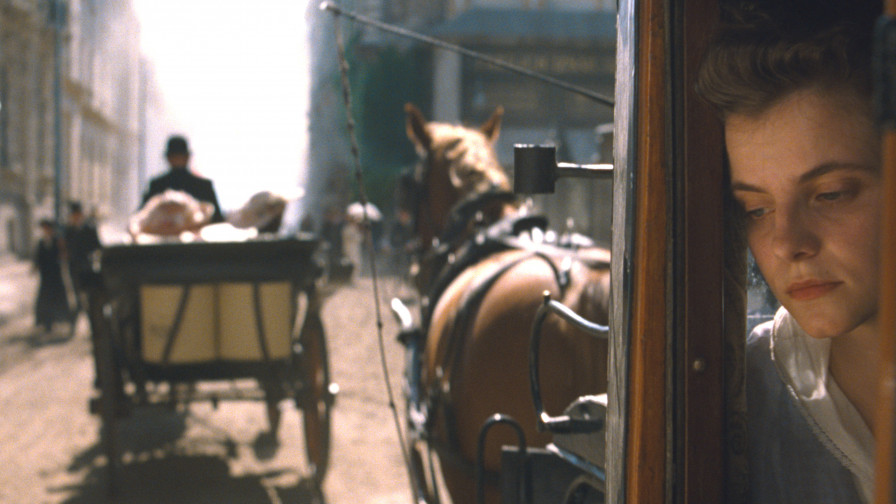"We Were Searching for The Lost Beauty" - interview with Györgyi Szakács
One of the main themes of 'Sunset' is searching for beauty. How it is reflected in the costume design of the movie?
This era means the lost beauty for me. In post-compromise Hungary, manufacturing industry, architecture, and art developed rapidly, and in parallel, tailoring and dressing rose to a high standard. At that time, it was not by chance that Budapest was called the Paris of Eastern Europe. I did not know this world personally, but thanks to my mother, as a child, I moved about a lot in the world of the salons of Váci Street, among others in the famous salon of Clara Rothschild, where I was surrounded by the objects and old aristocratic ladies of this bygone age. These quality garments and jewels shed the impulse of another world, which forever disappeared with the First World War. Women still had time to make these detailed, selfishly beautiful dresses which require a great deal of attention—even with their own hands. The 1910s were also the world of Art Nouveau, of a very volatile, decadent visuality and philosophy. There are times in history when culture reaches a very high degree of sophistication, but something is boiling deep down that breaks this super development. The rococo before the French Revolution, or Art Nouveau before the First World War were similar eras. In 'Sunset', we wanted to display something from this pre-storm state.
Was it difficult to reproduce this lost world?
Our most important objective is not to lie, and to create a credible world. We did not fish for garments from costume warehouses but used original antique pieces which I have been collecting for several decades, and we also made new ones from authentic, natural materials—silk satin and linen with genuine bobbin lace—that already existed in the first years of the century. I wanted to avoid operetta or onpurpose fashionista stylisation, flamboyancy in a bad sense, and fake colour palettes. I was trying to achieve that the viewer sees real people instead of people dressed in costumes.
The protagonist of 'Sunset' is a daughter of a family running a hat store. What does her costume reveal about her?
Irisz Leiter is a pure soul, whom we wanted to dress in blue from the very beginning. In painting, light blue as a colour is rich in meaning, it suggests inner purity. In the film, Irisz wears blue and purple costumes, the colours of the iris, as these two colours are the most characteristic of this flower. This is complemented by the somewhat standing white batiste collar which was fashionable back then. I was really surprised when, by chance, I came upon my grandmother's photo from the 1910s where she also wore a similar collar. This collar is indirectly similar to the petals of a flower, but I do not like to construe such specific things in my job, we did not want to use too straightforward symbols. For example, the hat with iris flowers drawn on it that I designed for Irisz was quickly thrown away. With the costumes we wanted to present a kind of restrained, stifled beauty.
What kind of fabric was Irisz's dress made of?
I've been looking for a fabric that can crinkle and responds sensitively to the effects that influence it, similarly to the girl who wears it. I made Irisz's costume from silk batiste, which is becoming more and more crinkled and dirty as she submerges into darkness.

Györgyi Szakács
It is interesting that both films try to capture the era with titles related to the Sun. I approached 'Sunset's costumes in a different way that I approached 'Sunshine'— partly because István Szabó's film tells the story of three generations and three periods: the 1890s, the 1920s and the 1950s. It does not present the 1910s directly, in which 'Sunset' takes place. Men's fashion, which is more limited, and prefers uniforms, has not changed much during these twenty years, however, women's dresses have had different silhouettes, so I had to design different types of dresses for the two films. In the 1890s, the sleeves were even bigger, the waists were slimmer, and the bottom of the skirts were fuller. By the 1910s, skirts got straighter, women wore different types of corsets, because wasp waist was no longer the most important thing, and big hats came into fashion.
In 'Sunset', a millinery plays a key role.
In costume history, this is the time when an incredibly rich hat culture has evolved, in Budapest, for example, there were more than a thousand hat shops. Hats were the adornments of garments. A lady would never leave the house without a hat and a pair of gloves. This was especially true during the hot summer when she was protecting her skin from the sun. Giant cartwheel hats were in fashion, and Mátyás Erdély, cinematographer, were a bit afraid that they would shield the face of protagonist Juli Jakab, but fortunately hers was still of a manageable size. Of course, the size of the hat Irisz is wearing also has its meaning: she arrives in Budapest with a light summer hat, then borrows another one in the millinery, but as he gets into the puddle, she loses her headwear.
Tamás Soós
